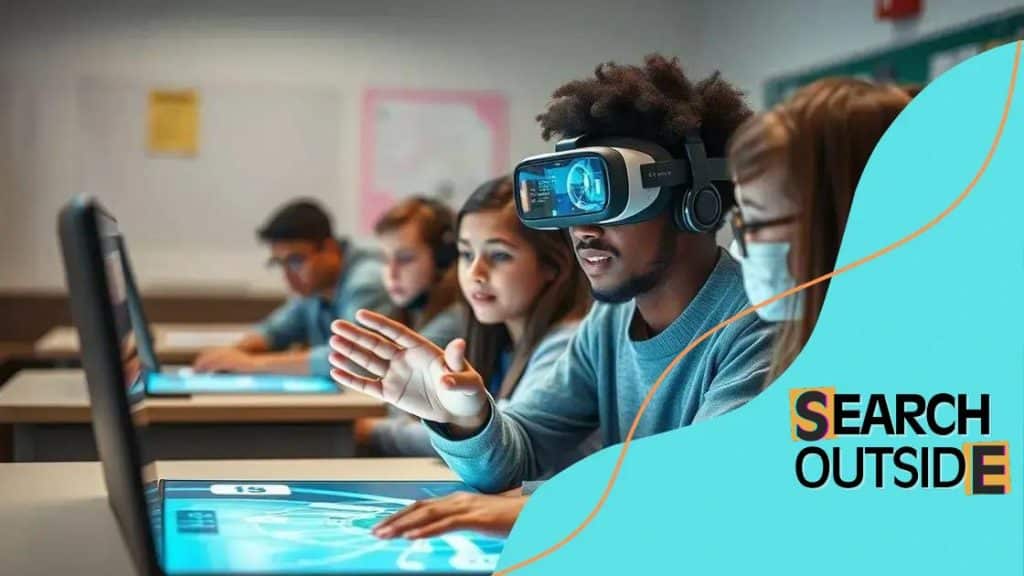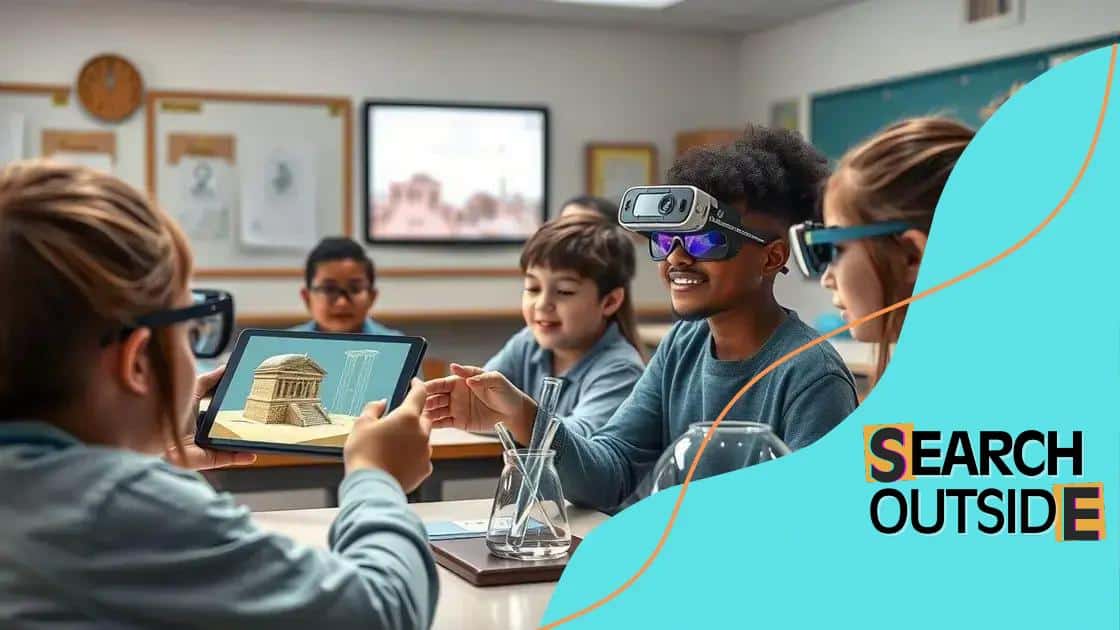How AR is being used for hands-on learning experiences

Augmented reality (AR) enhances hands-on learning by creating interactive experiences, allowing students to visualize complex concepts and engage actively with the material, ultimately improving understanding and retention.
How AR is being used for hands-on learning experiences is transforming education. Imagine students not just reading about the solar system but experiencing it firsthand through immersive technology. This article will explore how AR enriches learning.
Understanding augmented reality in education
Understanding augmented reality (AR) in education can transform how students learn and engage with the material. This innovative technology superimposes digital information onto the real world, creating interactive learning experiences. AR helps bridge the gap between theoretical knowledge and practical application.
When students interact with AR, they immerse themselves in their studies. For instance, during science lessons, they can explore the anatomy of the human body by examining it from various angles. This method makes learning more tangible and exciting.
Key Features of Augmented Reality in Education
Some of the most compelling features of AR include:
- Interactive simulations that engage students deeply.
- Real-time information that updates based on student interaction.
- Enhancement of traditional learning materials, making them more dynamic.
Using AR in classrooms not only captures students’ attention but also fosters a deeper understanding of complex concepts. Students can visualize abstract ideas, making learning more effective.
Benefits of AR in Educational Settings
Utilizing augmented reality can lead to numerous advantages:
- Enhances student motivation and interest in the subject matter.
- Provides personalized learning experiences that cater to different learning styles.
- Encourages collaboration among students through shared experiences.
These benefits show why AR is becoming increasingly popular in educational institutions. As technology evolves, the potential for improved learning experiences grows significantly.
Integrating augmented reality into lessons prepares students for a world where technology plays a crucial role. By making learning interactive, educators can inspire the next generation of curious minds.
Benefits of AR for hands-on learning
The benefits of augmented reality (AR) for hands-on learning are significant and wide-ranging. This technology not only makes lessons more engaging but also enhances the learning experience in profound ways. By integrating AR, educators can create an immersive environment that brings subjects to life.
When students use AR, they can interact with three-dimensional models, giving them a deeper understanding of complex topics. For example, in a biology class, students can examine a 3D model of a cell, exploring its parts in detail.
Enhanced Engagement
One of the most notable benefits of AR is the enhanced engagement it fosters among students. When lessons are interactive, students are often more excited to learn. With AR, lessons can include:
- Visual storytelling that captures students’ attention.
- Interactive quizzes that reinforce knowledge.
- Real-world applications that students can relate to.
These elements make learning not only fun but also effective. The involvement of students in their own learning process empowers them and promotes better retention of information.
Personalized Learning Experiences
AR also provides the opportunity for personalized learning. Each student learns at their own pace, and AR can adapt to their unique learning needs. For instance, students who struggle with certain concepts can receive immediate feedback and additional resources through AR tools. This customization helps all students succeed.
Furthermore, by using AR, students can visualize their progress in real-time, which can motivate them to keep improving and exploring new challenges.
Incorporating augmented reality into hands-on learning helps students develop critical thinking skills. They can experiment, make mistakes, and learn from them in a low-risk environment. This hands-on approach encourages creativity and innovation in problem-solving.
Real-world applications of AR in classrooms

Real-world applications of augmented reality (AR) in classrooms are becoming increasingly common, revolutionizing the way subjects are taught. Teachers can now utilize AR to create interactive and immersive experiences for their students. This integration enhances student understanding and engagement, making lessons more memorable.
For instance, in a history class, students can explore ancient civilizations by using AR to view ruins and artifacts in 3D. This experience can transform a traditional lesson into an exciting journey through time.
Science Simulations
AR is particularly useful in science education, where it allows students to conduct virtual experiments safely. With AR, they can:
- Observe cellular processes in real-time.
- Interact with chemical reactions without using dangerous substances.
- Visualize complex anatomical structures, like the human body.
These simulations provide opportunities for hands-on learning, encouraging students to ask questions and explore concepts in depth.
Language Learning
Augmented reality is also making waves in language education. Through AR apps, students can practice vocabulary and grammar in augmented contexts. For example, they can point their devices at objects in the classroom to see their names and uses in a different language. This method helps reinforce learning and builds confidence in using a new language.
Additionally, immersive AR experiences allow for cultural exploration. Students can “visit” different countries and learn about customs and traditions, providing a more holistic language learning experience.
From virtual field trips to interactive lessons, the application of AR is endless. Engaging students through technology can promote significant educational advancements, helping students connect classroom lessons to the real world more effectively.
How to effectively integrate AR into learning
Integrating augmented reality (AR) into learning requires strategic planning and an understanding of educational goals. Schools need to focus on how AR can enhance lessons and engage students effectively. By carefully considering the needs of the curriculum, educators can create meaningful experiences.
One way to start is by choosing the right AR tools and applications that align with learning objectives. For example, teachers can use AR apps that provide interactive lessons in subjects like science, math, and history. Choosing tools that offer real-time feedback can also enhance the learning process.
Creating Engaging Lesson Plans
To successfully implement AR, educators should design lesson plans that incorporate AR experiences seamlessly. Effective lesson plans can include:
- Interactive demonstrations that allow students to visualize concepts.
- Hands-on projects that require students to use AR for research.
- Collaborative activities where students work in groups to explore AR content.
These strategies promote deeper understanding and foster teamwork among students.
Training Educators
Training teachers on how to use AR technology is crucial for its successful integration. Professional development sessions can equip educators with the necessary skills and knowledge. Teachers can learn to:
- Navigate AR applications confidently.
- Incorporate AR lessons into their existing curriculum.
- Engage students effectively through interactive content.
When educators are comfortable with the technology, they can better inspire students to learn. Moreover, ongoing support is essential for addressing challenges that may arise during implementation.
Additionally, it’s important to evaluate student progress regularly. Using assessments that measure how well students are grasping AR-enabled lessons helps teachers adjust their teaching methods. Gathering feedback from students about their experiences can also provide insights into how to improve AR integration.
Future trends in AR for education
The future trends in augmented reality (AR) for education look incredibly promising. As technology advances, we can expect AR to become a vital tool in classrooms, enhancing how students learn and interact with information. By embracing these trends, educators can prepare students for a future that is ever more reliant on technology.
One major trend is the increased accessibility of AR tools. More affordable AR devices and applications are becoming available, allowing schools with various budgets to incorporate this technology. As these tools become commonplace, we can expect more educators to experiment with immersive lessons.
Personalized Learning Experiences
Future AR applications are likely to focus on personalization. This means tailoring content to fit individual learning styles and paces. Students will be able to explore subjects in different ways that suit their preferences. For instance, visual learners may benefit from 3D models, while auditory learners can access interactive storytelling features.
Collaborative Learning Through AR
Another trend is the emphasis on collaborative learning. AR can allow students to work together in virtual environments, completing projects or solving problems as a team. These collaborative experiences can foster teamwork and communication skills. Future classrooms may have students using AR headsets to engage in group activities, making learning a more social experience.
In addition to collaboration, the incorporation of virtual reality (VR) alongside AR is expected to grow. Combining these technologies can create fully immersive learning environments, offering students unique experiences that they cannot gain from traditional methods.
As technology evolves, educators will also likely focus more on data analytics through AR. By collecting data on student interaction and engagement, teachers can adjust their methods to better meet students’ needs. This form of assessment will help improve learning outcomes and foster success.
FAQ – Frequently Asked Questions about Augmented Reality in Education
How does augmented reality enhance learning experiences?
Augmented reality makes learning more interactive and engaging, allowing students to visualize complex concepts and participate in hands-on activities.
What are some examples of AR applications in classrooms?
Examples include virtual field trips, 3D anatomy models for biology, and interactive history lessons that bring historical events to life.
Can AR be used for personalized learning?
Yes, AR can tailor educational content to fit individual learning styles and paces, providing a more customized learning experience.
What trends are shaping the future of AR in education?
Future trends include more affordable AR tools, increased focus on collaboration, and the integration of data analytics to assess student engagement and progress.





